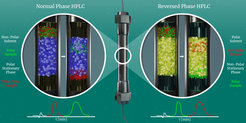High Performance Liquid Chromatography (HPLC)
In HPLC the separation mechanism is based on different adsorption characteristics of a given substance on a solid/stationary phase. In normal-phase HPLC (NP-HPLC) a polar stationary phase (e.g. silica) in combination with a non-aqueous nonpolar mobile phase is used for samples soluble in organic solvents, so that the substances elute depending on their polar interactions (such as hydrogen bonds or dipole interactions).
In contrast, samples soluble in aqueous solvents are separated on a non-polar stationary phase (containing e.g. alkyl chains) where the elution depends on the hydrophobic interactions of the sample. This type of HPLC is called reversed-phase HPLC (RP-HPLC).
To enhance the separation, a gradient elution is often used, meaning that the solvent composition does not remain constant (isocratic) during the measurement.

Possible applications:
- purity of substances
- separation of oligomer mixtures
- confirmation of reaction conversion
- monitoring of reaction kinetics
...and much more
Literature:
| Contact: | Beate Müller | ||
| Phone: | 06131-379-225 |
